Pride:
Echoes of Stonewall
story by Joe Giordano
published June 26, 2019
The uprising at New York’s Stonewall Inn on June 28, 1969, is something that is not widely taught in American classrooms or easily found in the pages of history textbooks.
Chaos Faulder first learned about the watershed event — in which transgender, gay and lesbian people stood up to police 50 years ago in a Greenwich Village bar, catalyzing the movement for LGBTQ rights — as a first-year student at Colorado State University through the Pride Resource Center.
Faulder, a fifth-year psychology student originally from Anchorage, Alaska, now works at the front desk in the center in the Lory Student Center. It’s a place where anyone in the campus community can find resources and support to explore their understanding of sexual/romantic orientation and gender and identity intersection.
“I think it’s really important to know where we came from to get here,” Faulder said. “I think a lot of times with Pride Month [in June], we can get very caught up in being proud, which is the point of it. But I think it’s really important to realize that this hasn’t always been the case.”
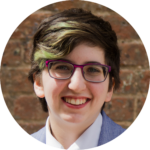
“I think it’s really important to know where we came from to get here.”
— Chaos Faulder, CSU student
Dora Frias, director of the Pride Resource Center, had only seen the brief snapshots from the national media about Stonewall before she started researching the event on her own after graduate school.
The names of two transgender women of color — Marsha P. Johnson and Sylvia Rivera — resonated with her. Both Johnson and Rivera were among the first people at the Stonewall Inn to resist arrest.
“I think some of the history gets told from a white perspective, and the fact that trans women of color played a role in that movement gets lost,” Frias said. “So for us, it’s important to talk about that.”
In many ways, the Pride Resource Center is leading the conversation here in Fort Collins, filling in the missing pages about Stonewall and other significant events in the LGBTQ rights movement through its programs, advocacy and outreach.

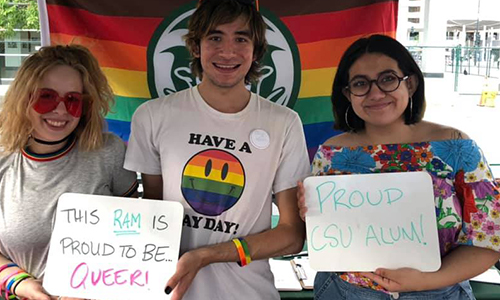
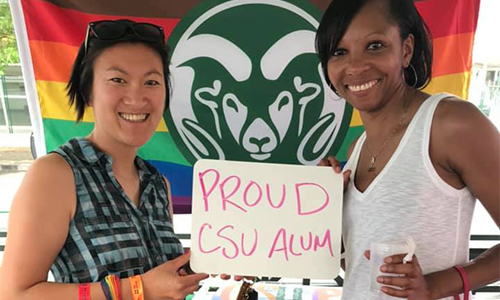
CSU students, alumni and future students participate in Denver PrideFest. Photos courtesy of the Pride Resource Center
Looking back: Gay Lesbian Bisexual Transgender Student Services
Lisa Phelps first heard about Stonewall as an undergraduate in New York in the 1980s, but it wasn’t until she became a CSU graduate student that she really started to understand the history.
After earning her degree, Phelps went to work as assistant director of residence life and served as the adviser of the Student Organization for Gays, Lesbians, Bisexuals (SOGLB) at CSU.
In 1997, SOGLB and the Associated Students of Colorado State University proposed the university establish an office dedicated to serving gay, lesbian, bisexual and transgender students. After working closely with the vice president of student affairs and with the support of private donors, Gay Lesbian Bisexual Transgender Student Services was established in the fall of 1998, with Phelps as the first director.
“The very first time I walked into that office downstairs [in the Lory Student Center] and seeing our name at the door – I will never forget that memory,” said Phelps, who now works as a program administrator for the University of Maine Cooperative Extension.
Gay Lesbian Bisexual Transgender Student Services would later change its name to the Lesbian Gay Bisexual Transgender Queer Questioning and Ally Resource Center in 2013 and the Pride Resource Center in 2016.
GLBT Student Services opened its doors right around the 10th anniversary of National Coming Out Day. It was also around the time of the murder of Matthew Shepard, a 21-year-old University of Wyoming student who was killed for being gay.
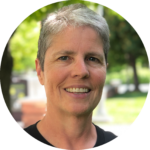
“People were just numb … They just couldn’t believe someone was brutally beaten for being their self.”
— Lisa Phelps, first Pride Resource Center director on the murder of Matthew Shepard
Prior to his death, Shepard was taken by rescuers from outside Laramie to Poudre Valley Hospital in Fort Collins. Phelps said the tragedy hit the CSU community hard, as quite a few students interacted with Shepard during his frequent visits to Fort Collins.
“People were just numb,” recalled Phelps, who took two vans with students to Shepard’s memorial service in Wyoming. “There was anger. They just couldn’t believe someone was brutally beaten for being their self.”
In those nascent years, Phelps said, the center provided a safe place, where LGBTQ students could come and hang out and be themselves. It provided support during traumatic events and offered educational opportunities to the CSU community to help counter stereotypes.
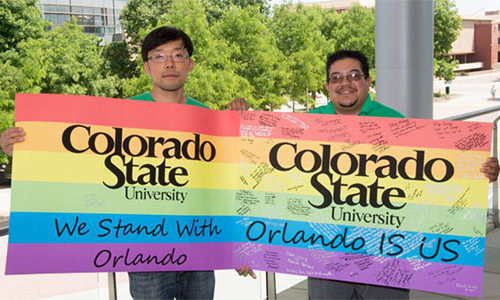
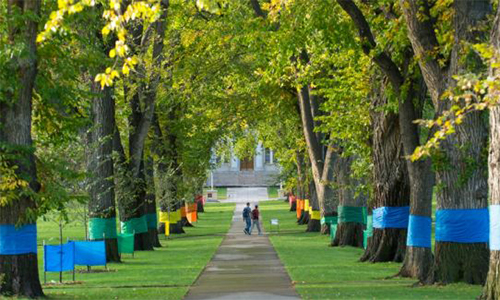
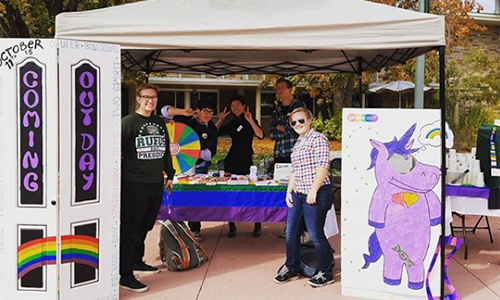
The Pride Resource Center has a visible presence on campus, providing resources and support to the CSU community.
Looking forward: Pride Resource Center
From time to time, Phelps likes to visit the Pride Resource Center, without mentioning her past role, to talk openly with students and see how the center has changed.
“Each of the times I’ve gone back, there’s that feeling of community and support,” Phelps said. “The positive energy and the good vibes in the office are the things that seem to be constant.”
Frias, who took over as director in 2017 after Aaric Guerriero moved to the University of Wisconsin in Madison, is building upon the foundation that Phelps and others created.
In her first year, she led the organizing efforts to celebrate the Pride Resource Center’s 20th anniversary. The project gave her the opportunity to connect with Phelps as well as Barb Kistler, the CSU staff member directly involved with the beginnings of LGBTQ support and visibility on campus.
Frias said the research that went into the celebration helped her understand the nuances of how identity has grown over the course of 20 years.
“The one thing in learning the history is that as queer and trans people, we are never taught our history in schools’ curriculum, and so we have to do that work on our own,” she said.
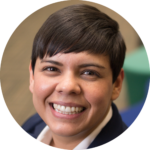
“We are never taught our history in schools’ curriculum, and so we have to do that work on our own.”
— Dora Frias, director of the Pride Resource Center
Frias said understanding past national events, such as Stonewall and Shepard’s murder as well as the Orlando nightclub shooting in 2016, offers parallel perspectives to what’s happening now.
In the case of Stonewall, Frias mentioned police brutality as an issue that continues today.
“While we can say we have gay marriage, the underlying systemic oppression is still there,” Frias said. “Some of the same issues are still happening 50 years later.”
To combat this, the Pride Resource Center teaches students about LGBTQ history and offers training and workshops to student organizations, faculty and staff to help increase the knowledge, awareness, skills and action needed to eliminate homophobia and transphobia and to create a place that is inclusive and supportive to the LGBTQ community.
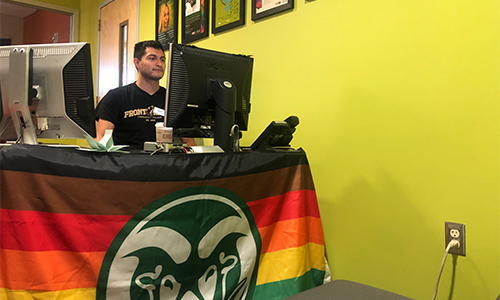
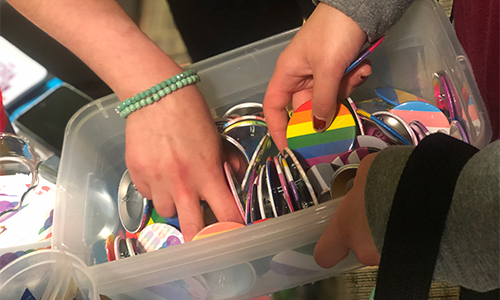
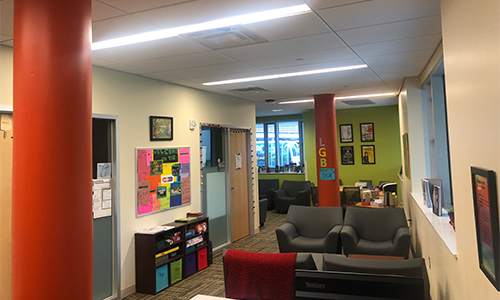
Located on the first floor of the Lory Student Center, the Pride Resource Center is part of the Student Diversity Programs and Services Cluster within the Division of Student Affairs of CSU.
Remembering Stonewall
The Pride Resource Center has come a long way from its beginnings in the basement of the Lory Student Center, and not just to its current home on the first floor.
On a recent Thursday afternoon, a smiling Faulder was sitting at the front desk, reflecting the positive atmosphere of the space.
For Faulder, the Pride Resource Center isn’t just a place to work — it’s home. It’s the place where Faulder discovered the field of psychology, studying to one day pursue a career as a marriage counselor specializing in same-sex couples.
“Most of my friends at CSU have been through the center,” Faulder said. “It’s really nice to just be able to be here and know that even if someone isn’t necessarily well informed, they usually want to learn.”
Plans to commemorate the 50th anniversary of Stonewall are still in the works for the fall semester when students return. However, the Pride Resource Center did partake in one of the results of Stonewall by participating in Denver PrideFest, one of the many pride parades and events across the country in June.
The center staffed an information booth in Civic Center Park, where students, alumni and even future students visited to show their support. “An important part of Pride Month is lifting up people who need help, which can be the whole queer and trans community, or it can be specific people who need our help,” Faulder said.

“They were fighting for my rights, their rights, your rights, everybody’s rights.”
— Lisa Phelps, first Pride Resource Center director
Frias, who attended Denver PrideFest, said her views on pride parades has evolved over the years. “What it means for me now as a parent is exposing our daughter to a celebration of her moms,” she said, “and helping her to see that there are many folks like us and many families like us.”
Faulder, Frias and Phelps — three generations in the LGBTQ community — all agree more needs to be done to educate people about the history of Stonewall and other important events in the movement for LGBTQ rights.
But why?
For Phelps, it’s a simple answer.
“I feel like it’s all part of our community,” she said. “They were fighting for my rights, their rights, your rights, everybody’s rights.”